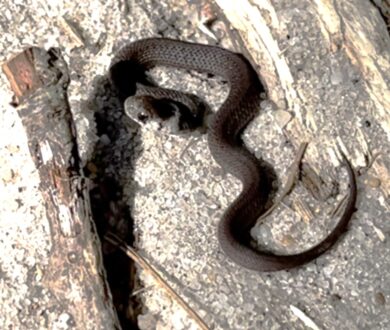DeKay’s Brownsnake on the Move?

Juvenile DeKay’s brownsnake, photographed by Megan Draheim.
Locally Rare Snake Documented in Second Location
(Originally posted on September 29, 2023, this blog was edited on October 2, 2023, to reflect evolving identification of an observation in iNaturalist. Experts have determined that a snake Initially identified as an adult DeKay’s brownsnake – and reported as such in the BiodiversityWorks eNews for September 2023 – was in fact an eastern garter snake, Thamnophis sirtalis sirtalis. The episode highlights the similarity between these two snake species and the occasional difficulty of identifying reptiles from photographs. One of the merits of iNaturalist is that identifications are never final: they can always be corrected or refined in response to new information or new insights.)
DeKay’s brownsnake (Storeria dekayi) was confirmed for the first time on Martha’s Vineyard in 2020 in Aquinnah, adding an eighth snake species to the island reptile checklist. Gus BenDavid, retired from Massachusetts Audubon after many years as the Felix Neck sanctuary director, had been searching for this reptile on the island since his childhood but had never found one. A keen observer in Aquinnah reported this unusual snake to him in 2020, and Gus and other experts were able to confirm its identity. No other sightings of this small, unobtrusive snake were reported until this past August 2, when Megan Draheim observed and photographed a small, odd-looking snake at Massachusetts Audubon’s Felix Neck Wildlife Sanctuary. Megan uploaded her photos to iNaturalist, and this snake turned out to be a juvenile DeKay’s brownsnake, which looks quite different from adults of the species. While adults are light brown to dark reddish brown with a double row of small black spots running down the back, juveniles are almost uniformly black with a faint white neck ring and can be mistaken for ring-necked snakes, which are far more common on the island.
Both the age and the location of this snake are significant. Roughly 13 miles from the site of the Aquinnah record, the occurrence of a DeKay’s brownsnake at Felix Neck strongly suggests the existence of at least two populations (or, conceivably, one very large, diffuse one) on the island. And the presence of a juvenile of this species suggests (though doesn’t irrefutably prove) that DeKay’s brownsnakes are successfully reproducing on the Vineyard.
So how did these little guys get here? Well, it’s not provable that the species wasn’t here all along, overlooked by even the most dedicated human observers, as Gus BenDavid speculated following the Aquinnah sighting. But on the other hand, wild animals are resourceful, and human travel and commerce create many opportunities for plants and animals to disperse. It’s certainly possible that individual DeKay’s snakes have been imported here, even on multiple occasions, along with wood chips or some other type of landscaping material. Which explanation is correct may ultimately be an unanswerable question. But in any event, it’s a fascinating situation and one that would have gone undiscovered if it weren’t for the alert work of naturalists in Aquinnah and at Felix Neck.
Wildlife Biologist Luanne Johnson is the Executive Director of BiodiversityWorks. Matt Pelikan is the director of the Martha’s Vineyard Atlas of Life project at BiodiversityWorks.